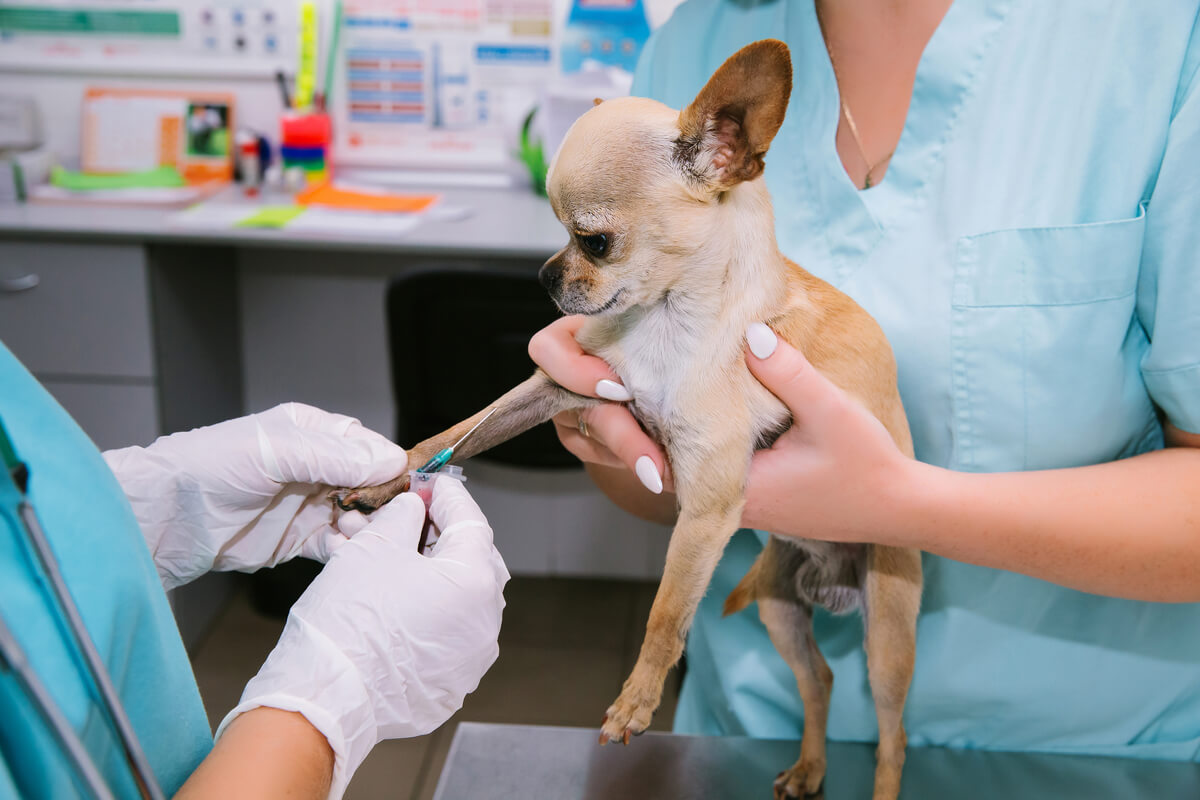Caring for a Dog with Anemia


Written and verified by the biologist Samuel Sanchez
Every owner needs to have a basic idea of how to care for a dog with anemia. This blood mismatch is common in humans – up to 11% of adults over 65 suffer from it – and that’s why it sounds familiar to all of us. However, what we maybe don’t realize is that anemia can also occur in dogs, cats and other vertebrates.
This condition can have many triggers, including parasitic diseases, hypothyroidism, cancer, autoimmune diseases, influenza, and poor nutrition. Here we’ll tell you all about this medical condition and we’ll place special emphasis on maintaining the health of the canine patient from home. Don’t miss it.
What’s anemia in dogs?
Red blood cells are cell bodies that are synthesized in the bone marrow – within certain bones of the dog – and then released into the blood. These fulfill the very important function of transporting the oxygen attached to hemoglobin to all the body’s tissues, including the brain and the heart.
In anemic conditions, there’s a reduction in the number of circulating red blood cells. In a normal situation, 35 to 55% of the dog’s blood is composed of red blood cells. However, if this value is lower than the 35% already mentioned, the analyzed dog is considered to have anemia, as indicated by Central Texas veterinary.
This condition can be classified into two large groups:
- Regenerative anemia: In this condition, the bone marrow responds to the lack of red blood cells and begins to synthesize more of them.
- Non-regenerative anemia: The bone marrow doesn’t respond adequately to the need for more red blood cells.

Causes of anemia in dogs
As you may have seen, anemia isn’t a disease per se, but a medical sign – low red blood cell count – that indicates an underlying disease. Among all the causes of the lack of circulating red blood cells, we can highlight the following:
- Injury, trauma, and internal bleeding: In these cases, red blood cells are “lost” in vomiting, stools, or an open wound that won’t stop bleeding. These types of anemias are usually regenerative, as the problem isn’t in the bone marrow and it’s working normally.
- Parasitic infestations: Some parasites – such as mites, fleas and ticks – feed on the dog’s blood. A major infestation can disrupt the red blood cell count.
- Tumors that bleed continuously, whether malignant or benign.
- Autoimmune diseases: In this type of condition, red blood cells are produced normally, but are destroyed by white blood cells and other cell bodies by mistake. The immune system recognizes red blood cells as threats and kills them.
- Nutritional imbalances: Without iron and other vital compounds, the bone marrow can’t synthesize the adequate number of red blood cells.
Thus, a dog may be anemic from loss of blood (bleeding), from the mistaken destruction of red blood cells (autoimmune reactions), or from the inability to synthesize red blood cells in the bone marrow. Each type of anemia has a special medical approach.
Symptoms of anemia in dogs
Observing anemia in dogs with the naked eye is very difficult, as it occurs in a general way and can be confused with many other clinical signs. An anemic dog in a mild part of the spectrum will become fatigued over time and will want to do fewer activities than normal. Therefore, the owner often believes that his pet has depression.
Beyond these initial signs, in the long term we’ll notice that the dog develops bruises more easily – loss of platelets – and that their gums are paler than normal. On the other hand, if the cause of anemia is internal bleeding, the dog will produce vomiting and blackened stools.
Caring for a dog with anemia
Now you know what this medical condition entails, the causes, and the most obvious symptoms. In the following lines, we’ll look at how to look after a dog with anemia, both from home and at the vet. Don’t miss it.
Blood transfusion
If the anemic condition is severe and the dog’s life is in danger, a blood transfusion may be necessary. However, before proceeding with this delicate process, a blood test must be performed on the dog for diagnostic purposes and to see what type of blood it has and which one it’s compatible with.
This approach is very effective in restoring normal circulating red blood cell values, especially if the cause of the anemia is severe internal or external bleeding. However, it’s still necessary to treat the underlying problem – parasites, wounds, cancer or autoimmune diseases, among others.
Corticosteroid treatment
If the anemia is due to an autoimmune disease, long-term treatment with corticosteroids is usually necessary, as indicated by the VCA Hospitals portal. Some drugs such as prednisolone cause immunosuppression, so the action of white blood cells and other bodies in destroying red blood cells can be prevented.
Typically, the treatment is prescribed for a few months and the dog is expected to improve. Little by little the drugs should be stopped, but relapses are very common. In some cases, corticosteroid treatment is life-long.
Anthelmintics and other antiparasitics
As we’ve said in previous lines, sometimes the problem is a group of parasites feeding on the dog’s blood. In these cases, the treatment involves deworming the animal, generally with internal anthelmintics or ointments and skin repellants – in the case of ticks and fleas.
Changes in diet
Finally, it should be noted that anemia can arise from a lack of iron in the diet, a condition known as iron deficiency anemia. This condition is more common in large breed dogs, which require a very high caloric and nutritional intake due to their accelerated growth rate.
Nutritional supplements, dried seaweed, some meats, animal entrails and various types of vegetables are rich in iron or facilitate its absorption. With the help of your vet, it’s possible to prioritize some foods for the anemic dog until its condition stabilizes.

As you can see, all the care and treatment for a dog with anemia is carried out through a visit to the vet and professional management. Be it mild or severe, this condition should be treated seriously and you should never choose to try to fix it from home without supervision. In animal health issues, pharmacology and veterinary medicine must be given preference over traditional remedies.
All cited sources were thoroughly reviewed by our team to ensure their quality, reliability, currency, and validity. The bibliography of this article was considered reliable and of academic or scientific accuracy.
- How is anemia in dogs diagnosed? Central Texas veterinary. Recogido a 15 de julio en https://www.ctvsh.com/resources/education/dog/anemia-dogs#:~:text=Thirty%2Dfive%20to%20fifty%2Dfive,count%20and%20the%20hemoglobin%20count.
- Feldman, B. F., Kaneko, J. J., & Farver, T. B. (1981). Anemia of inflammatory disease in the dog: clinical characterization. American journal of veterinary research, 42(7), 1109-1113.
- Scagnelli, A. M., Walton, S. A., Liu, C. C., & Acierno, M. J. (2018). Effects of therapeutic plasma exchange on serum immunoglobulin concentrations in a dog with refractory immune-mediated hemolytic anemia. Journal of the American Veterinary Medical Association, 252(9), 1108-1112.
- Heffner, G. G., Cavanagh, A., & Nolan, B. (2019). Successful management of acute bilirubin encephalopathy in a dog with immune‐mediated hemolytic anemia using therapeutic plasma exchange. Journal of Veterinary Emergency and Critical Care, 29(5), 549-557.
- Yuki, M., & Naitoh, E. (2019). Complete Remission of Associative Immune-Mediated Hemolytic Anemia in a Dog Following Surgical Resection of Intestinal Leiomyosarcoma. Veterinary sciences, 6(2), 55.
This text is provided for informational purposes only and does not replace consultation with a professional. If in doubt, consult your specialist.